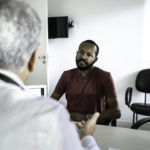
By James E. Grue, OD,
Ronald P. Snyder, OD, FAAO,
Michael J. Lipson, OD, FAAO, FSLS,
and Greg Caldwell, OD, FAAO
Sept. 1, 2021
Your diagnosis, and presentation of a treatment plan, are not enough to make a successful patient outcome likely. The patient also needs to be empowered to follow through on your treatment plan.
In our last article in this series we suggested you begin asking two questions of each diabetic patient and record each patient’s answers in the section called “patient concerns” in your electronic health record:
1) “When you think about your diabetes, what worries you? What concerns about your diabetes keep you awake at night? “
2) “What challenges are keeping you from getting better control of your diabetes? What makes it difficult for you to improve your control? “
In this article we demonstrate how to use the patient’s responses to those questions to empower the patient to become a critical part of their own healthcare team.
Using Patient Responses to Key Questions to Empower Care
In our earlier article, we asked readers to send us the more interesting responses they received to those two questions we recommended they pose. We plan to use those responses in this series of articles to discuss how you can incorporate the additional information you collect to enhance care. How you use those answers depends on a critical decision you have to make: Do you see your role in managing patients with diabetes as simply detecting diabetic retinopathy, or are you following the AOA Updated Guidelines on the Management of Diabetes and the principles put in place through healthcare reform to help the patient reduce their risk of developing retinopathy?
The most commonly cited evidence-based study for this change in approach is the Diabetes Control and Complications Study, which has been ongoing for over 30 years. It involves Type 1 diabetic patients, but similar results have been found in Type 2 diabetics. It shows that if HbA1c is lowered from an average of 9 to 7 over a 10-year time period, the amount of retinopathy is reduced by over 50 percent, and in some patients, by as much as 76 percent. This and other studies make it clear that there is an important role and opportunity for us to expand our influence as providers in helping the patient reduce their risk of developing retinopathy.
The lessons we learned through healthcare reform show that if our goal of care is to get the patient to change their behavior, as in the case of managing diabetes, we need to empower the patient to make better decisions. Those decisions will result in modifications in lifestyle which will in turn lower their HbA1c and reduce their risk of developing retinopathy.
Engage with Patient to Deliver Evidence-Based Care
The rest of this article, and the remainder of the series, is only for providers who want to change their role to deliver evidence-based care by engaging with the patient in a way that empowers the patient to understand their role in managing their diabetes. The ultimate goal is to help the patient reduce their risk of developing retinopathy.
If you are going to adopt this newer role of empowering the patient, you first need to know what patient empowerment means. The World Health Organization (WHO) has identified four components fundamental to the process of patient empowerment:
1) Understanding by the patient of his/her role in their overall health
2) Acquisition by patients of sufficient knowledge to be able to engage with their healthcare provider
3) Patient skills-communication
4) The presence of a facilitating environment
Based on these four components, WHO defines empowerment as: “A process in which patients understand their role, are given the knowledge and skills by their healthcare provider to perform a task in an environment that recognizes community and cultural differences and encourages patient participation.”

To learn more: 844.393.3282. (toll free) or ContactUs@HealthCareRegistries.com
Now let’s go back to the questions we suggested in our last article that you start asking diabetics. These questions fit in the process above as the starting point of helping you understand where the patient is in their journey to becoming an “empowered” patient.
The first question is: “What keeps you up at night that you worry about because of your diabetes?” The answer to this question is going to tell you how to orient the rest of your conversation with the patient. This is going to expose the patient’s most important concerns and guide you on how to empathize with the patient’s concerns. More importantly, the patient is telling you their fears that have to be addressed for them to make better decisions.
Two of the responses that patients gave to the question were:
1) “I am afraid that my diabetes will eventually make it so I can’t do things with my grandkids”
2) “My grandfather and two uncles both went blind from diabetes. In my family, it is inevitable that everyone who gets diabetes losses vision.”
The patient has just told you the key to getting their buy-in to taking better control. Let’s look at how you could respond to the second answer above.
Provider: “How long ago did your grandfather go blind”
Patient: “He has been dead for 15 years, so it was about 20 years ago. I can remember him sitting in his rocking chair trying to read his large-print bible and being frustrated as it became harder and harder for him to do that.”
Provider: “It sounds like you were close to your grandfather. I am sure your grandfather wouldn’t want you to go through that either. Fortunately, today there are many things that both you and I can do that will dramatically decrease the possibility that you will have to.”
Show the Patient How to Work as a Team with You
At this point, as a provider, you could pull out a graph showing the percentage of patients that went blind over time historically compared to the number that do today. Outcome analytics are designed to be shared with the patient. Numerous studies have shown how impactful the data is in helping patients understand their treatment options.
Remember, your conversation with the patient is helping the patient learn what they can do to optimize their care. Here, as a provider, you can start introducing the idea of working as a team. I would say something like: “There are things I can do and things you and I can do together, with the rest of your healthcare team that will result in completely different results than your grandfather and uncles experienced. Take a look at this.”
Then you might show the patient an OCT Angiography (OCTA) image of the foveal avascular zone and explain how this type of technology works. It graphically shows how we can see and track these changes in the small vessels in their eye. You could go on to explain how the same vascular changes are likely happening in other parts of their body as well. These changes will ultimately lead to changes that could affect their vision, as well as lead to other systemic complications of diabetes. You could also show the patient an image of what visible retinopathy looks like and explain how those changes are likely what led to their grandfather’s loss of vision. You could further explain that as a provider, you can now monitor these early vascular changes in ways that weren’t possible at the time the patient’s relatives experienced their vision loss.
Other Articles to Explore
Following that, you are able to start addressing the patient’s role. Explain that as a patient, it is the decisions they make every day, what they eat, how much they exercise, whether they take their medications and how closely they monitor their glucose, that affects their HbA1c. Help them understand that getting better control of their HbA1c will lower the risk of the microvascular changes that you will follow with the OCTA.
The conversation can now transition to what the patient can do. The answer the patient has given to the second question will guide that portion of the conversation. That question is: “Your diabetes is not well controlled at this point, what challenges have you been facing in getting better control?” Those answers will be the focus of our next article in this series. As a preview, the answers to those questions will direct your whole approach to what needs to be done to empower the patient. Every future discussion with the patient will be guided by the answers to that second question.
In summary, you have used the patient’s response to the first question to learn how to focus your discussion with the patient in a way that addresses their concerns. You have helped the patient understand the value of a team approach to their healthcare and the role they play on that team. If you go back to the four steps in the process to empower the patient, you have addressed the first two steps. You are helping the patient understand their role and how to engage with you and the rest of their healthcare team in a way that empowers the patient.
The next article will look at the answers to the second question. You will see how those answers guide you in addressing the third and fourth steps in the process of empowering the patient.
 James E. Grue, OD, is a health-care reform speaker and consultant. To contact him: JimGrue@HealthCareRegistries.com
James E. Grue, OD, is a health-care reform speaker and consultant. To contact him: JimGrue@HealthCareRegistries.com
 Ronald P. Snyder, OD, FAAO, is the president and CEO of HealthCare Registries, LLC. To contact him: RonSnyder@HealthCareRegistries.com
Ronald P. Snyder, OD, FAAO, is the president and CEO of HealthCare Registries, LLC. To contact him: RonSnyder@HealthCareRegistries.com
 Michael J. Lipson, OD, FAAO, is the chairman of the OrthoK Advisory Panel of HealthCare Registries, LLC.
Michael J. Lipson, OD, FAAO, is the chairman of the OrthoK Advisory Panel of HealthCare Registries, LLC.
 Greg Caldwell, OD, FAAO, is Chairman of the Advisory Panel for the Diabetes Management Registry.
Greg Caldwell, OD, FAAO, is Chairman of the Advisory Panel for the Diabetes Management Registry.
Photo credit, top of page: Getty Images

























